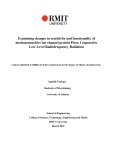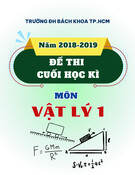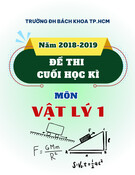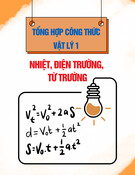Electromagnetic Field and Wave
Pham Tan Thi, Ph.D. Department of Biomedical Engineering Faculty of Applied Science Ho Chi Minh University of Technology
Maxwell’s Equation
Maxwell discovered that the basic principles of electromagnetism can be expressed in terms of the four equations that now we call Maxwell’s equations:
(1) Gauss’s law for electric fields; (2) Gauss’s law for magnetic fields, showing no existence of magnetic
monopole. (3) Faraday’s law; (4) Ampere’s law, including displacement current;
Maxwell’s Equations
Differential form:
~E =
Integral form: Gauss’ Law ~E
d~S = r · ⇢ "0 · Qinside "0 I
Gauss’ Law for Magnetism
~B d~S = 0 ~B = 0 · r ·
I Faraday’s Law
~E d~l = ~E = – d�B dt � · @ ~B @t r ⇥
I Ampere’s Law
~B d~l = µ0Ienclosed + µ0"0 ~B = µ0 ~J + µ0"0 d�E dt · @ ~E @t r ⇥ I
Macroscopic Scale
Microscopic Scale
Gauss’s Law for Electric Field
The flux of the electric field (the area integral of the electric field) over any closed surface (S) is equal to the net charge inside the surface (S) divided by the permittivity ε0.
~E
d~S =
·
Qinside "0
I
~E dxdyˆn =
d~S = ˆndS = ˆndxdy
·
~E dxdycos✓ =
· Qinside "0 Qinside "0
dx
Edxdy =
dy
Qinside "0
→ dS →
ES = E(4⇡r2) =
Qinside "0
Coulomb’s Law
E =
Qinside (4⇡r2)"0
Gauss’s Law of Magnetism
Gauss’s law of magnetism states that the net magnetic flux through any closed surface is zero
~B
d~S = 0
·
I
The number of magnetic field lines that exit equal to the number for magnetic field lines that enter the closed surface
→ E
~E
d~S =
·
Qinside "0
I
Faraday’s Law
The electric field around a closed loop is equal to the negative of the rate of change of the magnetic flux through the area by the loop.
~E
d~l =
~E d~l
d�B dt
·
�
~Ed~l = Edlcos✓ · = Edl
(θ = 0)
I
E(2⇡R) =
d�B dt
e.m.f =
� d�B dt �
e.m.f =
d�B dt �
= Ed
W = F d = Eqd W d V = Ed = e.m.f
Ampère’s Law with Maxwell’s Correction
The line integral of magnetic field over a closed path is equal to the total current going through any surface bounded by the closed path
~B d~l = µ0Ienclosed + µ0"0
d�E dt ·
1. Time-changing electric fields induces magnetic fields
2. Displacement current
cause Magnetic field
Conduction currents ( motion of charged particles)
Time changing electric fields
also cause Magnetic field
=> Time changing electric fields is equivalent to a current. We call it dispalcement current.
I
Ampère’s Law with Maxwell’s Correction
The line integral of magnetic field over a closed path is equal to the total current going through any surface bounded by the closed path
~B d~l = µ0Ienclosed + µ0"0
d�E dt ·
I
(when θ = 0)
~B d~l = Bdlcos✓ = Bdl
·
~B d~l = µ0Ienclosed +
d�E Bdl = B(2⇡R) dt ·
Z
I B(2⇡R) = µ0I
B =
µ0I 2⇡R
Ampère’s Law with Maxwell’s Correction
The line integral of magnetic field over a closed path is equal to the total current going through any surface bounded by the closed path
~B d~l = µ0"0 + µ0Ienclosed
d�E dt ·
I
For S1:
~B d~l = µ0Ienclosed
·
I For S2:
~B d~l = 0
·
I
Two different situations in even one case!
Ampère’s Law with Maxwell’s Correction
The line integral of magnetic field over a closed path is equal to the total current going through any surface bounded by the closed path
~B d~l = µ0"0 + µ0Ienclosed
d�E dt ·
I
Displacement current
Electric flux is defined as
~E d~S = �E =
· Qinside µ0
For S2:
~B d~l = µ0Ienclosed + µ0"0 dQ µ0 = µ0"0 dt d dt dQ dt · Q "0 ◆ ✓ I
Recall: Maxwell’s Equations
Differential form:
~E =
Integral form: Gauss’ Law ~E
d~S = r · ⇢ "0 · Qinside "0 I
Gauss’ Law for Magnetism
~B d~S = 0 ~B = 0 · r ·
I Faraday’s Law
~E d~l = ~E = – d�B dt � · @ ~B @t r ⇥
I Ampere’s Law
~B d~l = µ0Ienclosed + µ0"0 ~B = µ0 ~J + µ0"0 d�E dt · @ ~E @t r ⇥ I
Macroscopic Scale
Microscopic Scale
Convert Intergral form to Differential form
~E d~l = ~E d~S = d�B dt · � · Qinside "0 I I
~E d~S = dV ~Bd~S
· ⇢ "0 d~l = ~E · d d d~l = ~Bd~S dt dt � � ·
I ~E I
Stokes’ theorem: the circulation of a field E around the loop l that bounds a surface S is equal to the flux of curl E over S
Z Z ZV Divergence theorem: the flux penetrating a closed surface S that bounds a volume V is equal to the divergence of the field E inside the volume
~E)dS ~E)dS ~E d~S = ~E)dV ( d~l = ( ~E · d~l = ( r ⇥ · r ⇥ · r · ~E I I
~E +
dS = 0
( )dV = 0
r ⇥
� r · Z Z ZV ⇢ ~E "0 Z Z ZV
@ ~B @t ! @ ~B @t
~E = ~E = – r · ⇢ "0 r ⇥
Divergence Operator
Divergence at a point (x,y,z) is the measure of the vector flow out of a surface surrounding that point.
= ˆx
+ ˆy
+ ˆz
Fig. 4: Zero divergence
~E = ˆxEx + ˆyEy + ˆzEz @ @z
@ @x
@ @y
r
Fig. 3: No variation → zero divergence
~E =
+
+
@Ex @x
@Ey @y
@Ez @z
r ·
@Ez
~E = + +
≡ (rate of change of E in x direction) + (rate of change of E in y direction) + (rate of change of E in z direction)
Fig. 5
Fig. 1: Positive divergence at P
Fig. 2: Negative divergence at P
@Ex 1 @x @Ey @y @z r ·
Curl Operator in a Spherical Coordinate
Curl is a measure of the rotation of a vector field.
~E = ˆxEx + ˆyEy + ˆzEz
= ˆx
+ ˆy
+ ˆz
@ @x
@ @y
@ @z
r
Fig. 1: Non-zero curl
~E =
Fig. 2: How much is the curl?
3
2
r ⇥
ˆx ˆy ˆz @ @ @ @x @y @z Ex Ey Ez
4
= ˆx
+ ˆy
+ ˆz
5 @Ey @z
@Ez @x
@Ex @y
@Ez @y �
@Ex @z �
@Ey @x �
✓
◆
✓
◆
✓
◆
≡ (how much does an object in y-z plane rotate) + (how much does an object in x-z plane rotate) + (how much does an object in x-y plane rotate)
Curl =
Circulation Area
Curl Operator in a Cylindrical Coordinate
Curl is a measure of the rotation of a vector field.
~E = ˆ⇢E⇢ + ˆ�E� + ˆzEz
= + +
1 ⇢ @ @⇢ 1 ⇢ @ @� @ @z r
⇢
r ⇥
ˆ� 1 1 ⇢ ˆ⇢ ⇢ ˆz @ @ @ 3 @⇢ @� @z E⇢ E� Ez
@(⇢E�)
~E =
ˆ�
+
@(⇢E�) @z
ˆ⇢ ⇢
@E⇢ @z
ˆz ⇢
@E⇢) @z
r ⇥
@Ez @� �
�
@Ez @⇢ �
@� �
✓
◆
✓
◆
✓
◆
~E = 2 6 4 7 5
Differential form: Gauss’ Law for Magnetism
⟺
~B d~S = 0 ~B = 0 ·
+
+
1 r
@rBr @r
1 r
@B� @�
@Bz @z
r ·
�Bin I ~B = = 0 ~B = r · �Bout �
=
a
= 0
1 a
@ @r
µ0I 2a
✓
◆
volume r ·
�B = BA
B =
µ0I 2⇡a
Differential form: Faraday’s Law
⟺
~E d~l = ~E = – d�B dt · � @ ~B @t r ⇥ I
curl of ~E =
⇢
@ ~B @t � r ⇥
=
Circulation Area @ ~B @t �
~E = E� =
ˆ� 1 1 ⇢ ˆz ⇢ ˆ⇢ @ @ @ 3 @z @⇢ @� E⇢ E� Ez 0 0 7 5 @ ~B ⇢ 2 @t ˆz ⇢ ~E = 2 6 4 ˆz ⇢ � r ⇥
@ ~B @t �
~E = ˆz ⇢ ~E = @ ~B @t 1 2 r ⇥ ~E(2⇡⇢) ⇡⇢2 = @ ~B @t ⇢ 2
Differential form: Ampere’s Law with Maxwell’s Corr
⟺
~B d~l = µ0Ienclosed + ~B = µ0 ~J + µ0"0 d�E dt · @ ~E @t r ⇥ I
=
J: Current density J =
I A I ⇡R2
~B = = µ0 ~J
Circulation Area r ⇥
B(2⇡R) ⇡R2 = µ0 ~J
B(2⇡R) ⇡R2 = µ0 Ienclosed ⇡R2
B = µ0
Ienclosed 2⇡R
Differential form: Ampere’s Law with Maxwell’s Corr
⟺
~B d~l = µ0Ienclosed + ~B = µ0 ~J + µ0"0 d�E dt · @ ~E @t r ⇥ I
Start from:
~B = µ0 ~J
r ⇥ Take divergence:
( ~J
r · r ⇥
~J = ~E) = "0
r · ("0r · � @ ~E @t ! �r ·
~B) = µ0r · @ @⇢ = @t @t ⇢ ( :charge density)
We need to add displacement current term
Differential form: Ampere’s Law with Maxwell’s Corr
~B = µ0 ~J
r ⇥
1 ⇢ ˆ⇢ @ @⇢ 0
1 ⇢ ˆz @ 3 @z 0
1 ⇢ ˆ⇢ @ @⇢ B⇢
= 3 r ⇥ r ⇥
ˆ� 1 ⇢ ˆz @ @ @� @z ⇢B� Bz ˆ� @ @� ⇢B�
@⇢B�
~B =
⇢
ˆ�
+
7 5 7 5
@⇢B� @z
ˆz ⇢
@0 @�
r ⇥
@0 @⇢ �
@0 @⇢ �
�
@⇢ �
✓
◆
✓
◆
✓
◆
~B = 2 6 4 ˆ⇢ ⇢ ~B = 2 6 4 @0 @z
~B = =
ˆz ⇢ @⇢B� @⇢ µ0I 2⇡⇢2 ˆz r ⇥
Varying current causes a circulating magnetic field
How Electromagnetism is a Wave in Vacuum?
~E = –
~B = µ0"0
@ ~E @t
r ⇥
@ ~B @t
r ⇥
~E)
@(
@(
~B)
~B = µ0"0
~E = –
r ⇥ @t
r ⇥ r ⇥
r ⇥ @t
r ⇥ r ⇥
~E)
(
2 ~E =
µ0"0 µ0"0
~B)
(
2 ~B = µ0"0
r
r ·
� r
r
r ·
� r
@ @t � �
@ ~B @ ~E @t ! @t !
@ @t �
@ ~B @t !
2 ~E
2 ~B
µ0"0 µ0"0
@2 ~B @t2 = 0 r � r �
Wave equation is in form
@2 ~E @t2 = 0 1 3 108m/s
where c =
10�
1 v2
d2y dx2 �
µ0 = 4⇡
⇥
d2y dt2 = 0 (cid:15482) Both Electric and
" = 8.85
10�
⇥
7 Wb A.m 12 C2 N.m2
⇥ pµ0"0 ⇡
Magnetism are waves
!t)
!t)
E = E0cos(kx
B = B0cos(kx
�
�
Magnetism vs Electric
Let’s work on one dimension
~E = –
r ⇥
kx)]ˆj ~E = [E0sin(!t = kx)]ˆi [B0sin(!t r ⇥ r ⇥ � @ @t �
@ ~B @t @ ~B @t @ ~B @t
~E = kx)]ˆi k[E0sin(!t kx)]ˆi = [!B0sin(!t r ⇥ � � �
(cid:15483)
kE0 = !B0 = = = f �
! k 2⇡f 2⇡/� E0 B0
= c
E0 B0
Energy of an Electromagnetic Wave
Start from the magnetic density:
1
c = 3 108m/s B2 = ⌘B = ⇥ pµ0"0 ⇡ E2 c2 1 2µ0 ◆
E2
(Electric energy density)
⌘B = µ0"0E2 =
1 2µ0 ✓ "0 2 1 2µ0
For an electromagnetic wave in free space, half of the energy is in the electric field and another half is the magnetic field
⌘ = ⌘E + ⌘B
⌘ = E2 E2 +
Total energy:
"0 "0 2 2 ⌘ = "0E2
Power density
Since waves are spread out in space and time, energy density is often a more useful concept than energy. The power of a wave should probably replaced with the more useful concept of its power density. The energy content of a wave fills a volume of space defines energy density as energy per volume u V
The power density is the power per area
⌘ =
S =
P A W m2
�
Poynting Vector
Power density is defined as
S = = =
P A 1 A u t 1 A ⌘V t
S = = = = ⌘c
⌘V At ⌘(Al) At ⌘(Act) At
S = ⌘c = B2
E B 1 µ0 ✓ ◆
S = EB S = ~E ~B
Poynting Vector
The magnitude of the Poynting vector represents the rate at which energy passes through a unit surface area perpendicular to the direction of wave propagation. The direction of the Poynting vector is along the direction of wave propagation.
⇥ 1 µ0 1 µ0

































